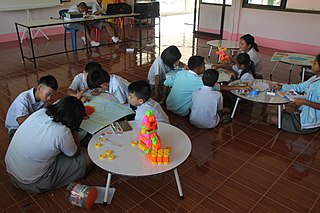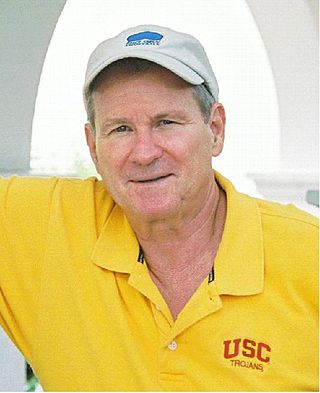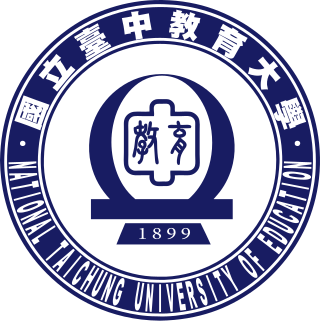Media literacy is an expanded conceptualization of literacy that includes the ability to access and analyze media messages as well as create, reflect and take action, using the power of information and communication to make a difference in the world. Media literacy is not restricted to one medium and is understood as a set of competencies that are essential for work, life, and citizenship. Media literacy education is the process used to advance media literacy competencies, and it is intended to promote awareness of media influence and create an active stance towards both consuming and creating media. Media literacy education is part of the curriculum in the United States and some European Union countries, and an interdisciplinary global community of media scholars and educators engages in knowledge and scholarly and professional journals and national membership associations.

Project-based learning (PBL) is a student-centered pedagogy that involves a dynamic classroom approach in which it is believed that students acquire a deeper knowledge through active exploration of real-world challenges and problems. Students learn about a subject by working for an extended period of time to investigate and respond to a complex question, challenge, or problem. It is a style of active learning and inquiry-based learning. PBL contrasts with paper-based, rote memorization, or teacher-led instruction that presents established facts or portrays a smooth path to knowledge by instead posing questions, problems, or scenarios.
The International School of Curitiba (ISC), founded in 1959, is located in Curitiba, Paraná, Brazil.
In the realm of US education, a rubric is a "scoring guide used to evaluate the quality of students' constructed responses" according to James Popham. In simpler terms, it serves as a set of criteria for grading assignments. Typically presented in table format, rubrics contain evaluative criteria, quality definitions for various levels of achievement, and a scoring strategy. They play a dual role for teachers in marking assignments and for students in planning their work.
A lesson plan is a teacher's detailed description of the course of instruction or "learning trajectory" for a lesson. A daily lesson plan is developed by a teacher to guide class learning. Details will vary depending on the preference of the teacher, subject being covered, and the needs of the students. There may be requirements mandated by the school system regarding the plan. A lesson plan is the teacher's guide for running a particular lesson, and it includes the goal, how the goal will be reached and a way of measuring how well the goal was reached.
In education, Response to Intervention is an approach to academic intervention used to provide early, systematic, and appropriately intensive assistance to children who are at risk for or already underperforming as compared to appropriate grade- or age-level standards. RTI seeks to promote academic success through universal screening, early intervention, frequent progress monitoring, and increasingly intensive research-based instruction or interventions for children who continue to have difficulty. RTI is a multileveled approach for aiding students that is adjusted and modified as needed if they are failing.
Family literacy is a method of education. Relatively new, family literacy is being put into practice in the United States, Canada, and South Africa.
Interdisciplinary teaching is a method, or set of methods, used to teach across curricular disciplines or "the bringing together of separate disciplines around common themes, issues, or problems.” Often interdisciplinary instruction is associated with or a component of several other instructional approaches. For example, in a review of literature on the subject published in 1994, Kathy Lake identified seven elements common to integrated curriculum models: a combination of subjects; an emphasis on projects; the use of a wide variety of source material, not just textbooks; highlighting relationships among concepts; thematic units; flexible schedules; and flexible student grouping.
Curriculum mapping is a procedure for reviewing the operational curriculum as it is entered into an electronic database at any education setting. It is based largely on the work of Heidi Hayes Jacobs in Mapping the Big Picture: Integrating Curriculum and Assessment K-12 and Getting Results with Curriculum Mapping. Schools are using curriculum templates that display key components of the curriculum: content, skills, assessments, and essential questions.
An edublog is a blog created for educational purposes. Edublogs archive and support student and teacher learning by facilitating reflection, questioning by self and others, collaboration and by providing contexts for engaging in higher-order thinking. Edublogs proliferated when blogging architecture became more simplified and teachers perceived the instructional potential of blogs as an online resource. The use of blogs has become popular in education institutions including public schools and colleges. Blogs can be useful tools for sharing information and tips among co-workers, providing information for students, or keeping in contact with parents. Common examples include blogs written by or for teachers, blogs maintained for the purpose of classroom instruction, or blogs written about educational policy. Educators who blog are sometimes called edubloggers.
Curriculum studies is a concentration in the different types of curriculum and instruction concerned with understanding curricula as an active force influenced by human educational experiences. Its proponents investigate the relationship between curriculum theory and educational practice in addition to the relationship between school programs, the contours of the society, and the culture in which schools are located.

The Association for Supervision and Curriculum Development doing business as ASCD is a membership-based non-profit organization founded in 1943. It has more than 125,000 members from more than 128 countries, including superintendents, principals, teachers, professors of education, and other educators. The ASCD Community also includes 52 affiliate organizations, self-organized Connected Communities, and ASCD Student Chapters.

Fenwick W. English is an education professor.
Floyd Grant Robinson was a teacher, education theorist and curriculum developer. He wrote many works on the topics of stimulating complex thinking and the importance of education across the entire lifespan. Robinson is most notable for his work done while at the Ontario Institute for Studies in Education (OISE) between 1965 and 1991.
Dr. Heidi Hayes Jacobs is an author and internationally recognized education leader known for her work in curriculum mapping, curriculum integration, and developing 21st century approaches to teaching and learning.
Classroom walkthrough is a model of professional development for teachers. Clinical supervision, or the practice of classroom observation and feedback has been one of the most often used tool in evaluating teacher performance, however the extent to which it helps teachers to improve their instruction is questionable. As a result, the classroom walkthrough, not designed for evaluation, but for the purpose of professional development, has gained increasing popularity.

The National Taichung University of Education is a university in West District, Taichung, Taiwan. Founded in 1899 at the Confucian Temple in Changhwa county, it moved to the current site in 1923.
Efforts to teach writing in the United States at a national scale using methods other than direct teacher–student tutorial were first implemented in the 19th century. The positive association between students' development of the ability to use writing to refine and synthesize their thinking and their performance in other disciplines is well-documented.

Differentiated instruction and assessment, also known as differentiated learning or, in education, simply, differentiation, is a framework or philosophy for effective teaching that involves providing all students within their diverse classroom community of learners a range of different avenues for understanding new information in terms of: acquiring content; processing, constructing, or making sense of ideas; and developing teaching materials and assessment measures so that all students within a classroom can learn effectively, regardless of differences in their ability. Differentiated instruction means using different tools, content, and due process in order to successfully reach all individuals. Differentiated instruction, according to Carol Ann Tomlinson, is the process of "ensuring that what a student learns, how he or she learns it, and how the student demonstrates what he or she has learned is a match for that student's readiness level, interests, and preferred mode of learning." According to Boelens et al. (2018), differentiation can be on two different levels: the administration level and the classroom level. The administration level takes the socioeconomic status and gender of students into consideration. At the classroom level, differentiation revolves around content, processing, product, and effects. On the content level, teachers adapt what they are teaching to meet the needs of students. This can mean making content more challenging or simplified for students based on their levels. The process of learning can be differentiated as well. Teachers may choose to teach individually at a time, assign problems to small groups, partners or the whole group depending on the needs of the students. By differentiating product, teachers decide how students will present what they have learned. This may take the form of videos, graphic organizers, photo presentations, writing, and oral presentations. All these take place in a safe classroom environment where students feel respected and valued—effects.

The term learning environment can refer to an educational approach, cultural context, or physical setting in which teaching and learning occur. The term is commonly used as a more definitive alternative to "classroom", but it typically refers to the context of educational philosophy or knowledge experienced by the student and may also encompass a variety of learning cultures—its presiding ethos and characteristics, how individuals interact, governing structures, and philosophy. In a societal sense, learning environment may refer to the culture of the population it serves and of their location. Learning environments are highly diverse in use, learning styles, organization, and educational institution. The culture and context of a place or organization includes such factors as a way of thinking, behaving, or working, also known as organizational culture. For a learning environment such as an educational institution, it also includes such factors as operational characteristics of the instructors, instructional group, or institution; the philosophy or knowledge experienced by the student and may also encompass a variety of learning cultures—its presiding ethos and characteristics, how individuals interact, governing structures, and philosophy in learning styles and pedagogies used; and the societal culture of where the learning is occurring. Although physical environments do not determine educational activities, there is evidence of a relationship between school settings and the activities that take place there.





